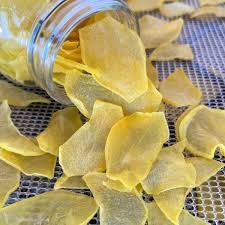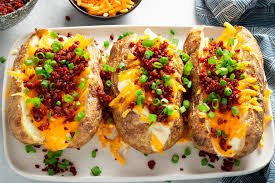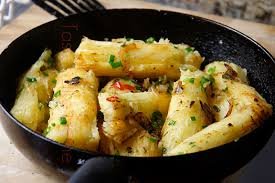
Potatoes (Solanum tuberosum L.) are one of the most important agricultural crops for human consumption after wheat, rice and maize. Over the years, potato has become an important crop for both farmers and consumers in Pakistan. It is the fourth most important crop by volume of production and it gives high yields and high returns to farmers. Potato having a high nutritive value and these contributes more protein and iron than other vegetables in the average diet and are also useful sources of thiamine, niacin and several other nutrients including fiber. Potato is eaten intensively in a variety of forms such as boiled, baked, and cooked. As vegetable it is eaten alone as well as mixed with other vegetables and as snacks, the most popular of them being the finger chips. It has medical significance also.
Potato value addition:
- Dehydrated potatoes: Dehydration of potatoes reduces the bulk to transport and also increases the shelf life of potatoes significantly due to less moisture, which arrests the growth of microorganism. Dehydrated potatoes flakes can be processed into onion powder by proper grinding. Dehydrated potato flakes are used in retail mashed potato products, as ingredients in snacks, and even as food aid. Potato flour, another dehydrated product, is used by the food industry to bind meat mixtures and thicken gravies and soups.

- Frozen potatoes: Potatoes can be cut into slices or French fries form and freezed in polyethylene bags at refrigeration temperature. Frozen potatoes, which includes most of the french fries served in restaurants and fast-food chains worldwide. The world’s appetite for factory-made french fries has been put at more than 7 million tons a year. Another processed product, the potato crisp is the long-standing king of snack foods in many developed countries.

- Potato cutlets: These are mashed potatoes rolled into small balls, and then dipped into eggs and deep-fried. You might also need ingredients such as grated carrots, ginger, coriander and lemon to flavour your cutlets. To prepare the cutlets, you need to peel the potatoes, boil them for 15 minutes until they are soft after which they are mashed. They are then dipped in eggs and shallow fried for five minutes until they are brownish in colour. Bread crams are then sprinkled on the surface of the cutlets to make them more delicious. They can be served with fish or chicken.

- Mashed potato: Potatoes are peeled, chop into pieces and boil for 15 minutes until they are soft. Pound them until they appeal paste-like. Mashing potatoes is a popular way of serving potatoes with only salt and butter or cream. Grated garlic and white pepper can also be thrown in to the mix for a rich a flavour. This dish can be served with beef or chicken stew.

- Roasted potatoes: Potatoes can be roasted whole and raw, though those starchy need a quick pre-cook in boiling water for seven minutes to make them soft. After washing the tuber, you may peel and, thereafter, cut it into thick wedges or cubes. Heat the oven to 450 degrees and spread the (raw) potatoes inside the oven. Sprinkle on the potatoes little oil and toss well so that it reaches all the sides. Keep adding oil and tossing to coat and sprinkling salt and any spices you might want on the potato. Roast for 20 to 30 minutes, then serve.

- Baked potato: The potato should be thoroughly washed but not peeled. Small amounts of herbs such as rosemary and parsley are also needed to add flavour to the baked potato need salt, sliced onions and white pepper for seasoning, and corn oil. The herbs and seasoning are then spread over the potato before corn oil is sprinkled liberally over the top. Bake in an oven at 200 degrees Celsius for 40 to 45 minutes. Use a sharp knife or a fork to test if the potatoes are soft enough and use a spoon to lift them on to a plate. You can take the tubers with tea or stew.

- Boiled potato: Boiled potatoes have a nice creamy texture once cooked. Wash the potatoes and chop into pieces before boiling for 15-20 minutes until the water is drained. Boiling only requires salt for seasoning, herbs such as thyme or garlic cloves and bay leaves or other spices can also be added to the cooking water to flavour the potatoes.

- Potato salad: while making salad. To make the salad, boil potatoes for 10 minutes until they are a bit soft. Take care not to over boil as they will fall apart (as in mashed potatoes). Once they are ready, slice them into chunks using a knife and let them cool. Put the chunks in a plate alongside sliced onions, and salad fruits.

- Boiling and frying: In boiling and frying, peeled potatoes are chopped into sizable cubes and boiled in salted water for 10 minutes. They are then drained and dried before being deep fried in corn or vegetable oil for about 15 minutes until they are brown. They are, thereafter, removed from the oil then left to cool. They can then be served just with juice, chicken tikka, fish fillets and fried beef.

- Chips or French fries:To make French fries, potatoes are peeled, sliced and chopped to 1cm sizes. They are then washed, dried and parboiled (partially boiled), then drained and left to cool. The chips are then blanched in a pan or fryer of oil at 155 degrees Celsius. Remove them and let them cool. When you are ready to serve, fry them again in heated oil two minutes at 185 degrees Celsius.

- Crisps: Place potato slices into a large bowl of cold water as you slice them as thinly as possible. Once they are cleaned, soak them in salty water for at least 30 minutes, then drain them and rinse. Thereafter, marinate (soak) them in a mixture of white vinegar to prevent the slices from disintegrating. Heat oil in a deep fryer to 185 degrees Celsius, then dip the potato slices to fry. Once they start turning golden, remove and drain on paper towels. Continue until all of the slices are fried. Season with additional salt if desired.

Non-food uses:
- Potato starch: Potato starch is widely used by the pharmaceutical, textile, wood, and paper industries as an adhesive, binder, texture agent, and filler, and by oil drilling firms to wash boreholes. Potato starch is a 100% biodegradable substitute for polystyrene and other plastics and used, for example, in disposable plates, dishes, and knives.
- Potato peel: Potato peel and other “zero value” wastes from potato processing are rich in starch that can be liquefied and fermented to produce fuel-grade ethanol.
